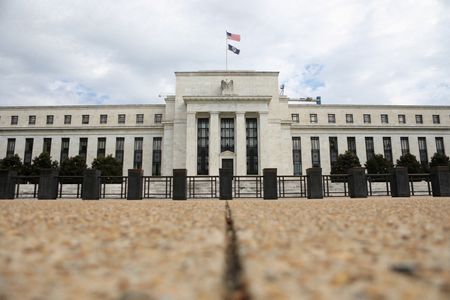By Ann Saphir
(Reuters) – U.S. central bankers are expected to keep their inflation fight in high gear this week, even as they intensify a debate over when to downshift to smaller interest rate hikes so as to avoid sending the world’s biggest economy into a tailspin.
With the Fed’s preferred measure of inflation running at more than three times its 2% target, the outcome of the central bank’s policy meeting on Tuesday and Wednesday is not in doubt: it will raise rates by three quarters of a percentage point for the fourth straight time, bringing the target overnight lending rate to a 3.75%-4.00% range.
But what’s next is less clear.
Personal consumption https://graphics.reuters.com/USA-STOCKS/zdvxdyaoxvx/pce.png
After the last meeting, in September, Fed Chair Jerome Powell said that “at some point” it will be appropriate to slow the pace of rate hikes and take stock of how the sharpest rise in borrowing costs in 40 years is affecting the economy.
Defining that point, or at least its parameters, will be the subject of intense discussion at this week’s Federal Open Market Committee meeting.
Do price pressures need to ease convincingly first?
Or is the bar simply that inflation needs to stop getting worse, even if it takes time to actually get better?
How will a looming recession in Europe, a slowdown in China, and rising global commodity prices stoked by the war in Ukraine impact the U.S. outlook for inflation?
How to account for the lagging effect of rising U.S. rates, which are slowing the housing market dramatically but have yet to bite into the broader economy or lift the unemployment rate, currently at 3.5%?
Projections released at the end of the Sept. 20-21 meeting suggest that most of the Fed’s 19 policymakers expect to be able to begin to slow the rate hikes in December and reach a peak policy rate of 4.50%-4.75% in 2023.
But economic data since that meeting has been mixed, with U.S. inflation still searingly hot but some signs that household spending and job growth are easing.
Past the peak? https://graphics.reuters.com/USA-FED/jnvwyglebvw/chart.png
And during that time, Fed policymakers, with the notable exception of Powell, have offered a range of views on where they stand on a possible slowdown or even pause to rate hikes.
Fed Governor Michelle Bowman, for instance, said she’ll look for signs that inflation is moving down before she would want to reduce the pace of rate hikes. Minneapolis Fed President Neel Kashkari signaled he would be comfortable if inflation simply stopped rising.
It isn’t clear that two days of debate are enough to resolve those differences.
“There does not yet appear to be a consensus on the Committee about the preferred size of a December hike, limiting Powell’s ability to offer guidance,” Nomura economists wrote on Friday.
The Fed chief will instead, those economists and others predict, point to the range of data still to come before any decision needs to be made – including two more monthly reports on the state of the U.S. job market and, most importantly, fresh inflation readings.
“There is little reason for the committee to limit its optionality for December, as even the most dovish participants would likely prefer more information about how inflation and overtightening risks are evolving before signaling a policy turn,” Barclays economists also wrote on Friday.
Fed risk sentiment https://graphics.reuters.com/USA-FED/SENTIMENT/mopakmkkepa/chart.png
‘NEED TO BE CONVINCED’
Bets in futures markets weigh heavily in favor of a slowdown in rate hikes starting in December, but ultimately a top Fed policy rate of 4.75%-5.00%, slightly higher than policymakers themselves have flagged, by early next year.
“Everything is squared up to do 50 (basis points) in December,” said Vincent Reinhart, chief economist at Dreyfus-Mellon, and then to raise rates a bit further to a plateau that’s high enough to put downward pressure on inflation.
Other global central banks are signaling slower tightening ahead, with the Bank of Canada shifting to a half-percentage-point hike last week and a slightly less hawkish tone from the European Central Bank as it announced its own 75-basis-point rate hike last week.
Fed policymakers, Reinhart said, are also well aware that monetary policy typically goes too far.
“You tighten too much, you ease too much, you wait too long because you need to be convinced,” he said. “And knowing that … they’ll slow the pace.”
Still, anything from Powell that suggests he views the Fed’s September projections as stale could upend expectations for a December downshift and set the stage for a more aggressive touch.
(Reporting by Ann Saphir; Editing by Paul Simao)

